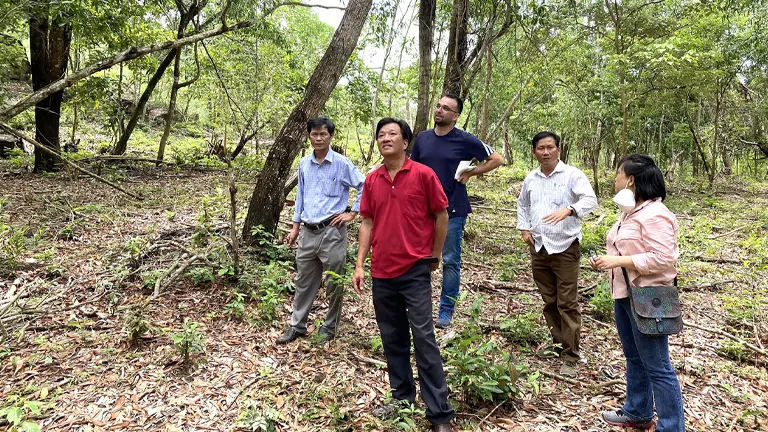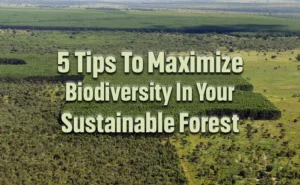Private Sector’s Role in Forest Management
- August 6, 2024
- 0 comment
Forests are vital for ecological balance, biodiversity, and human resources. Traditionally led by public agencies, forest management now sees significant private sector involvement, which includes conservation, sustainable resource use, and community engagement. Historically focused on timber extraction, private companies have shifted towards sustainable practices due to growing environmental awareness.

Today, corporations, NGOs, and private landowners actively contribute to forest conservation. They implement sustainable logging, reforestation, and carbon offset programs, while NGOs collaborate with communities and governments to protect and restore forests. The private sector’s involvement brings economic benefits, such as job creation and revenue, environmental benefits like biodiversity conservation and carbon sequestration, and social benefits including community engagement and education.
However, challenges remain in balancing profit with sustainability, regulatory compliance, and potential conflicts of interest. Successful public-private partnerships are essential for leveraging resources and expertise to achieve conservation goals.
Emerging technologies and increased corporate social responsibility are promising trends for future private sector engagement. By integrating sustainability into their core strategies, private companies can play a crucial role in maintaining forest health and resilience.
Private Sector in Forest Management

Forests, vital to ecological balance and biodiversity, are increasingly managed by private sector entities. This sector’s role is multifaceted, involving conservation, sustainable resource use, and community engagement. The private sector’s approach to forest management has evolved from mere exploitation to a more sustainable and responsible stewardship. This shift acknowledges that long-term profitability is intricately linked to environmental health.
Types of Private Sector Entities Involved
The private sector encompasses a range of entities, each playing a distinct role in forest management:
- Corporations: Many large companies are involved in sustainable logging, reforestation projects, and carbon offset programs. They implement advanced technologies and practices to minimize environmental impact.
- Non-Governmental Organizations (NGOs): NGOs often act as intermediaries, facilitating conservation projects and engaging with local communities to promote sustainable practices and restore degraded lands.
- Private Landowners: Individual landowners can significantly contribute to forest conservation by adopting sustainable land management practices that align with broader conservation goals.

Key Areas of Involvement
Private sector involvement spans several key areas:
- Conservation: Private entities engage in efforts to preserve biodiversity and protect endangered species. They establish protected areas and wildlife corridors, ensuring that ecological integrity is maintained.
- Sustainable Logging: Companies implement practices that reduce the environmental impact of logging, such as selective logging and reduced-impact logging techniques.
- Reforestation: Private sector initiatives often include planting trees to restore degraded landscapes, enhance carbon sequestration, and support local ecosystems.
Examples of Private Sector Projects and Initiatives
- The Nature Conservancy’s Working Woodlands Program: This initiative collaborates with private landowners to promote sustainable forest management while providing economic incentives through carbon credits.
- International Paper’s Forest Stewardship Program: This program focuses on sustainable forestry practices and partnerships with conservation organizations to protect and restore forests.
Benefits of Private Sector Involvement
The private sector’s involvement in forest management brings numerous benefits across economic, environmental, and social dimensions.

Economic Benefits
- Job Creation: Sustainable forestry projects create employment opportunities, particularly in rural areas where jobs may be scarce. These jobs range from fieldwork to administrative roles within conservation programs.
- Revenue Generation: Sustainable forest management can generate significant revenue through the sale of timber, non-timber forest products, and carbon credits, contributing to the local and national economy.
Environmental Benefits
- Biodiversity Conservation: Private sector initiatives help preserve diverse plant and animal species by protecting habitats and implementing sustainable practices.
- Carbon Sequestration: Reforestation and afforestation projects undertaken by private entities enhance carbon sequestration, mitigating climate change by capturing atmospheric carbon dioxide.
Social Benefits
- Community Engagement: Many private sector projects involve local communities, ensuring that they benefit from conservation efforts. This engagement often includes capacity-building and the provision of alternative livelihoods.
- Educational Programs: Private companies and NGOs frequently run educational campaigns to raise awareness about the importance of forests and sustainable management practices.
Challenges and Criticisms
Despite the benefits, private sector involvement in forest management faces several challenges and criticisms.

Balancing Profit and Sustainability
Balancing economic objectives with environmental sustainability can be challenging. The pressure to generate profits may sometimes lead to compromises in sustainable practices.
Regulatory Challenges
Regulatory environments vary widely, impacting the implementation of sustainable practices. Inconsistent regulations can create loopholes that undermine conservation efforts.
Potential for Conflicts of Interest
There is potential for conflicts of interest when commercial objectives clash with conservation goals. This can result in practices that prioritize short-term gains over long-term sustainability.
Partnerships and Collaborations
Successful forest management often hinges on effective partnerships and collaborations.

Examples of Successful Partnerships
- WWF and IKEA Partnership: This collaboration focuses on promoting responsible forest management and sourcing practices, leading to improved forestry standards and conservation outcomes.
- UNDP’s Green Commodities Program: This program partners with private companies to promote sustainable commodity production, benefiting both the environment and local communities.
Role of Public-Private Partnerships
Public-private partnerships leverage the strengths of both sectors, combining resources, expertise, and influence to achieve significant conservation outcomes. These partnerships can enhance the effectiveness of forest management initiatives.
Benefits of Collaboration for Long-Term Sustainability
Collaboration ensures that diverse perspectives and resources are utilized, leading to more comprehensive and sustainable forest management strategies. It fosters innovation and shared responsibility, ensuring long-term environmental health.
Future Trends and Opportunities
The future of private sector involvement in forest management is promising, with several emerging trends and opportunities.
Emerging Technologies in Forest Management
Technological advancements, such as remote sensing and artificial intelligence, offer new tools for monitoring and managing forests more effectively. These technologies can enhance the accuracy of data collection and improve decision-making processes.
Potential for Increased Investment in Sustainable Forestry
As awareness of environmental issues grows, there is potential for increased investment in sustainable forestry practices. This includes funding for reforestation projects, sustainable logging, and conservation initiatives.
Role of Corporate Social Responsibility (CSR) in Driving Forest Management Initiatives
Corporate social responsibility (CSR) is becoming a significant driver of forest management initiatives. Companies are increasingly integrating sustainability into their core business strategies, recognizing that responsible environmental practices can enhance their reputation and profitability.
Frequently Asked Questions (FAQs)
1. Why is the private sector involved in forest management?
The private sector is involved in forest management to leverage their resources, expertise, and innovation for sustainable practices. This involvement helps balance economic growth with environmental conservation, ensuring forests are managed responsibly and sustainably.
2. What types of private entities are involved in forest management?
Various entities, including corporations, non-governmental organizations (NGOs), and private landowners, play a role in forest management. Each entity contributes uniquely to conservation, sustainable logging, and community engagement.
3. How does the private sector contribute to conservation efforts?
The private sector contributes to conservation through initiatives such as establishing protected areas, implementing sustainable logging practices, reforesting degraded lands, and participating in carbon offset programs. These efforts help preserve biodiversity and mitigate climate change.
4. What are the economic benefits of private sector involvement in forest management?
Economic benefits include job creation, especially in rural areas, and revenue generation through the sale of timber, non-timber forest products, and carbon credits. These activities support local economies and contribute to national economic growth.
5. What environmental benefits arise from private sector engagement in forest management?
Environmental benefits include enhanced biodiversity conservation, increased carbon sequestration, and improved land use practices. Sustainable forestry practices help maintain ecological balance and support the health of forest ecosystems.
6. How does the private sector engage with local communities?
The private sector often engages with local communities through partnerships and collaborative projects. This engagement includes capacity-building initiatives, educational programs, and the provision of alternative livelihoods, ensuring communities benefit from conservation efforts.
7. What challenges does the private sector face in forest management?
Challenges include balancing profit motives with sustainability goals, navigating regulatory environments, and potential conflicts of interest between commercial objectives and conservation goals. These challenges require careful management and transparent practices.
8. Can you provide examples of successful private sector projects in forest management?
Successful projects include The Nature Conservancy’s Working Woodlands Program, which promotes sustainable forestry with economic incentives, and International Paper’s Forest Stewardship Program, focusing on sustainable practices and partnerships for forest protection.
9. How do public-private partnerships benefit forest management?
Public-private partnerships combine the strengths of each sector, leveraging resources, expertise, and influence to achieve significant conservation outcomes. These collaborations enhance the effectiveness of forest management initiatives and promote long-term sustainability.
10. What future trends and opportunities exist for private sector involvement in forest management?
Future trends include the use of emerging technologies like remote sensing and AI for better forest monitoring and management. Increased investment in sustainable forestry practices and the growing emphasis on corporate social responsibility (CSR) are also driving further private sector engagement.
11. How can private companies balance profit and sustainability in forest management?
Companies can balance profit and sustainability by integrating environmental considerations into their core business strategies, adopting sustainable practices, and participating in initiatives like carbon offset programs. Transparency and adherence to regulations are also crucial.
12. What role does corporate social responsibility (CSR) play in forest management?
CSR plays a significant role by encouraging companies to adopt sustainable practices and contribute to environmental conservation. CSR initiatives often include reforestation projects, sustainable sourcing, and community engagement, helping to drive positive environmental outcomes.

Gilbert Griffin
Forestry AuthorGilbert Griffin is a forest management expert specializing in sustainable practices, forest health, conservation, and land management. With extensive knowledge in pest control, disease management, and habitat restoration, Gilbert develops strategies to preserve forest ecosystems and biodiversity. Passionate about the natural world, Gilbert adapts to changes in forest management and stays updated through continuous learning. Gilbert also provides seasonal advice to optimize forest care throughout the year.













Leave your comment